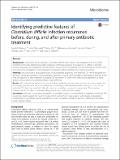Identifying predictive features of Clostridium difficile infection recurrence before, during, and after primary antibiotic treatment
Author(s)
Bhanvadia, Amit; Zhu, Roger; Amarnani, Abhimanyu; Gibbons, Sean M.; Martello, Laura A.; Pakpour, Sepideh; Gibbons, Sean Michael; Gurry, Thomas Jerome; Alm, Eric J; ... Show more Show less
Download40168_2017_Article_368.pdf (1.122Mb)
PUBLISHER_CC
Publisher with Creative Commons License
Creative Commons Attribution
Terms of use
Metadata
Show full item recordAbstract
Background: Colonization by the pathogen Clostridium difficile often occurs in the background of a disrupted microbial community. Identifying specific organisms conferring resistance to invasion by C. difficile is desirable because diagnostic and therapeutic strategies based on the human microbiota have the potential to provide more precision to the management and treatment of Clostridium difficile infection (CDI) and its recurrence.
Methods: We conducted a longitudinal study of adult patients diagnosed with their first CDI. We investigated the dynamics of the gut microbiota during antibiotic treatment, and we used microbial or demographic features at the time of diagnosis, or after treatment, to predict CDI recurrence. To check the validity of the predictions, a meta-analysis using a previously published dataset was performed. Results: We observed that patients’ microbiota “before” antibiotic treatment was predictive of disease relapse, but surprisingly, post-antibiotic microbial community is indistinguishable between patients that recur or not. At the individual OTU level, we identified Veillonella dispar as a candidate organism for preventing CDI recurrence; however, we did not detect a corresponding signal in the conducted meta-analysis. Conclusion: Although in our patient population, a candidate organism was identified for negatively predicting CDI recurrence, results suggest the need for larger cohort studies that include patients with diverse demographic characteristics to generalize species that robustly confer colonization resistance against C. difficile and accurately predict disease relapse.
Date issued
2017-11Department
Massachusetts Institute of Technology. Center for Microbiome Informatics and Therapeutics; Massachusetts Institute of Technology. Department of Biological EngineeringJournal
Microbiome
Publisher
BioMed Central
Citation
Pakpour, Sepideh, et al. “Identifying Predictive Features of Clostridium Difficile Infection Recurrence before, during, and after Primary Antibiotic Treatment.” Microbiome, vol. 5, no. 1, Dec. 2017.
Version: Final published version
ISSN
2049-2618